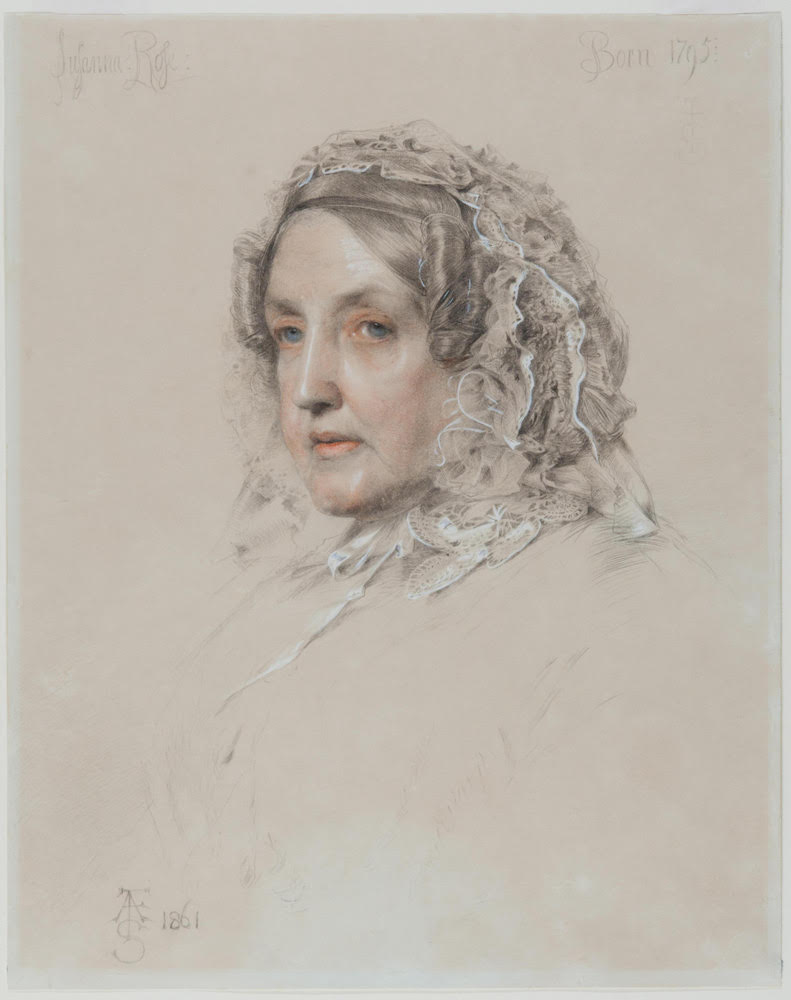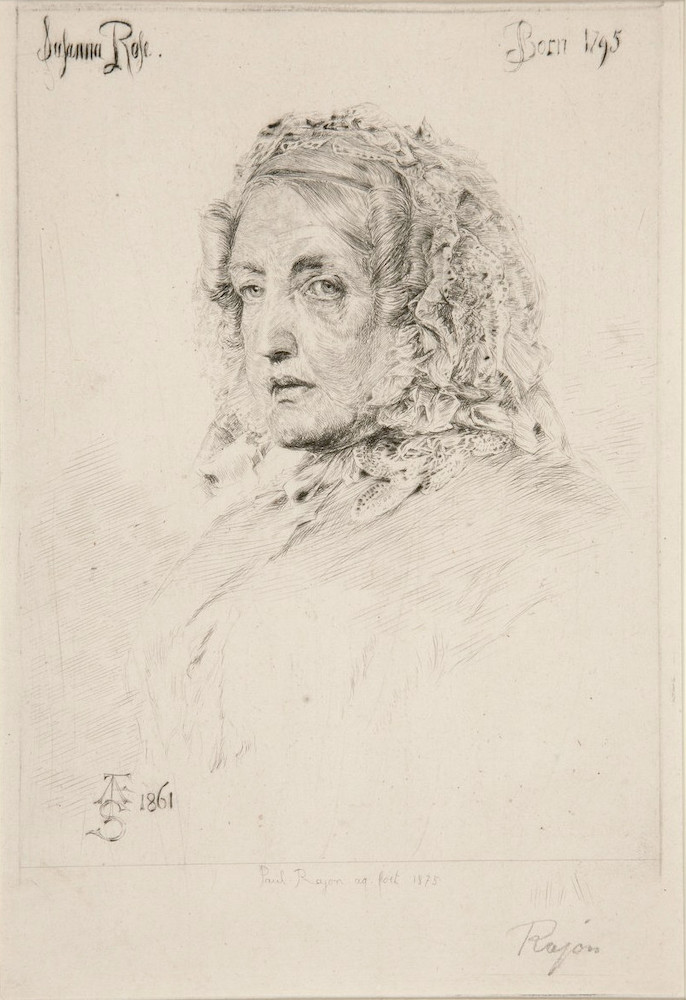

Mrs. Susanna Anderson Rose, by Frederick Sandys(1829-1904). Left: 1862. Oil on wood panel. 13 11/16 x 11 inches (34.7 x 28 cm). Cleveland Museum of Art, Mr. and Mrs. William H. Marlatt Fund 1979.81. Image courtesy of the Cleveland Museum of Art. Right: 1861. Pencil and chalks on paper. 17 ¼ x 13 ¼ inches (43.8 X 33.6 cm). Collection of the Philadelphia Museum of Art (accession no. 1993-19-1). Image courtesy of the Philadelphia Museum of Art. [Click on the images to enlarge them.]
Sandys exhibited the portrait in oils at the Royal Academy in 1863, no. 53, and then later that same year at the Manchester Institution, Exhibition of Modern Paintings and Sculpture, no. 100. It is surely one of the finest of his portraits of elderly women and helped to establish his artistic reputation. Susanna Rose (1795-1870) was the mother of James Anderson Rose who was Sandys's good friend, lawyer, and important patron. It was based on a preliminary drawing of 1861, now in the collection of the Philadelphia Museum of Art.
Betty Elzea has described the painting:
Half-length of an elderly woman facing half to the left, the eyes turned slightly towards the spectator. The head is almost completely covered by a lace and muslin cap trimmed with bright blue silk ribbon. Her white hair shows in front of the cap and is dressed with a ringlet on either side of the face. There is a narrow band of black velvet ribbon across her forehead (as in the ferronnière fashion of c. 1835), and a wider bow of it, which probably attaches to the cap, is beneath her chin. The tails of this bow partly hide a small brooch set with stones. Two interlocked rings seem to depend from one of the long tails. She wears a black velvet (?) dress with a lace collar, and a brown fur wrap surrounds her shoulders. Behind her head, as if on a screen, hangs a brocade panel of late medieval design, a device taken from late 15th and early 16th century devotional paintings, which Sandys had already used in some earlier portraits…. To the right of the sitter's head is a view through an open double window, showing a summer landscape with a lawn and a villa half hidden by shrubs and trees, with distant trees, hills, and sky beyond. Again this is the device from late 15th and early 16th century devotional and portrait paintings. [164]
The ferronnière head ornament that helped to hold hairstyles in place was a fashion that had gained popularity in 15th century Italy but was then revived in the 19th century, particularly the 1830s and 1840s. It can be seen depicted in Renaissance portraits, including Leonardo da Vinci's famous La Belle Ferronnière.
J.M. Gray speculated that the "Old Master" qualities of this portrait was inspired by the Flemish Renaissance works Sandys saw during a trip to Holland and Belgium he undertook in April 1862 with James Anderson Rose. (Gray 77-78). Elzea points out, however, that "the portrait had already been planned and started in 1861 when Sandys made the preliminary drawing. Indeed, Sandys already by this time had become an accomplished practitioner in the technique and style of the late 15th and early 16th century North European painters" (164-65).
William S. Talbot, who was at one time Associate Curator of Paintings at the Cleveland Museum of Art, which owns the picture, also emphasized the influence of Netherlandish or German painting of the fifteenth through sixteenth centuries on this work:
Much of Victorian painting, however, was far less conceptual and drew its strength from close observation. The Portrait of Mrs. Susanna Rose painted in 1862 by Frederick Sandys (1829-1904) has long been recognized as one of the finest British portraits of its period. Sandys created a keenly sympathetic portrait of old age by faithfully recording the appearance of Mrs. Rose in her sixty-seventh year in an intimate domestic setting. The transparent skin and fine wrinkles of advanced age were minutely observed, the wisps of thinning silvery hair noted, and the different materials in the bonnet-the blue ribbon twisting in and out of light and shadow past folds of heavy white lace or swirls of filmy gauze - have been caught with astonishing skill. Sandys has not missed the sparkling, slightly moist eyes or the animation of the slightly parted lips. From the hairs of the brown fur cloak to the distant landscape there is a clear-eyed regard for nature and an ability to render it with such intensity that the truth of Sandys's image is totally convincing. The space created in front of the hanging textile is very shallow, thrusting Mrs. Rose forward into a strong, even light. This effect is made even more striking by the great scale difference between the distant landscape and Mrs. Rose's face. There is a spatial discontinuity between the foreground and the rest of the interior which is typical of late medieval art. The medievalism of the painting is further established by the Rose coat of arms in the upper left with its charming motto "Constant and True" followed by the sitter's name and birth date of 1795 in gothic script. The artist's monogram at the lower left, worked into a shield format with the date of the painting, lends another medieval note. [298-99]
Talbot has also compared the preliminary drawing to the finished painting: "The chalk drawing portrayed Mrs. Rose as a bit more sharp of feature with a more rigidly arranged coiffure, and a slightly less elaborate and delicate bonnet. In the oil the large curls at each temple are softer and looser, a few wispy hairs straggle across her forehead instead of a severely disciplined part, and there is a fulness in the face, a tenderness in the moist eyes, and a marvellous elaboration of materials in the bonnet" (300).

Etching of 1875 in black ink on paper by Paul A. Rajon after Frederick Sandys. 9 1/2 x 6 1/2 inches (24.2 x 16.4 cm) – plate mark. Private collection, image courtesy of the author. [Click on the image to enlarge it.]
An etching of the portrait of Mrs. Rose by Paul Adolphe Rajon was executed in 1875. Another etching of this subject by Charles George Lewis was used as the frontispiece for A Collection of Engraved Portraits Catalogued and Exhibited by James Anderson Rose at The Opening of the New Library and Museum of the Corporation of London, November 1872 and published by Marcus Ward in 1874. An impression of this etching is in the collection of the British Museum, museum no. 1873,0712.1239.
Contemporary Reviews of the Painting
When the painting was shown at the Royal Academy in 1863 it was, in general, widely and enthusiastically reviewed. A critic for the Art Journal considered it the finest portrait in the exhibition: "The present exhibition contains yet another wonder after this kind, and that perhaps the greatest, in the head of Mrs. Susanna Rose (53), painted by Mr. F. Sandys. Nothing can be more perfect than this portrait, firm and precise in the drawing of every feature, matchless in the mapped exactitude of each detail touched in without effort, and therefore attaining to the greatest reality" (110). W.M. Rossetti in the Spectator commented on the Old Master influences of this portrait: "Mr. Sandys has chosen older masters for his models, with what good success the characteristic portrait of Mrs. Rose (53), in which care and delicacy of painting stop short of interfering with expression, will attest" (2036).
C. L. Eastlake in London Society was lavish in his praise:
Mr. Sandys' portrait of Mrs. Susanna Rose (53,) has merited in all opinions that terse, well-remembered eulogy, which Ruskin pronounced some years ago on Wallis's Death of Chatterton "faultless and wonderful." Never was the beauty of old age more aptly shown; never colour more tastefully associated. The diapered background alone is a charming study in itself. The tiny landscape seen through the open window to the right is worthy of the best age of old Flemish art. Yet all is kept subordinate to the individuality of the head, every feature of which is wrought out and finished with the greatest care, from the subtlest bloom of living colour on the cheek, to the silvered hair which peeps below the muslin cap. The possessors of such a family portrait as this may indeed be congratulated. [542]
A critic for the Times, likely Tom Taylor, praised its "Old Master" qualities: "F. Sandys is a new name, comparatively, but one destined to be much heard of, if it be attached to many pictures like the small portrait of Mrs. Susannah Rose, a noble-looking lady, with gray hair, in a room giving a peep of landscape through the window, as delicately finished and as harmonious as a background of Memling's. The head is elaborated with Denner-like [Balthazar Denner] minuteness, but its charm is not in this finish, but in the refined character and exquisite drawing of every feature. Mr. Sandy's work is of a quality that fair criticism cannot undervalue because the critic may prefer a larger and bolder execution" (11).
F.T. Palgrave in the Saturday Review felt Sandys was one of the more promising young artists in this exhibition:
Mr. Sandys, though, we believe known already as the author of some fine and firm drawings, must also be reckoned as a painter, amongst the men of promise in whom this Exhibition has been unusually fertile. The two heads by him which are hung at accessible heights, La Belle Ysonde, and Mrs. Rose (53 and 606), have struck everyone as remarkable examples of execution, in which careful drawing and significant expression are set off to the best advantage by significance in the accessories and care in the finish. There is, perhaps, a slight tendency to hardness in handling, and to archaism of style; but we trust that Mr. Sandys will not allow these temptations to divert him from what bids fair to be a career of unusual success. [728]
F.G. Stephens called special attention to this remarkable work in his review in the Athenaeum: "We gladly interrupt our progress with subject, pictures to call attention to an admirable portrait, by Mr. Sandys, of Mrs. Susanna Rose (53), hung near Mr. Cope's Music Lesson, the painter-like and brilliant qualities of which are highly to be appreciated. A lady in a cap with blue ribbons, the flesh, the genial character, brightness, and sound, not at all hard, finish of this work are remarkable" (622).
Bibliography
Bate, Percy "The Late Frederick Sandys: A Retrospective." The Studio XXXIII (October 1904): 12.
Eastlake, Charles Locke. "The Royal Academy Exhibition." London Society III (June 1863): 539-50.
Elzea, Betty. Frederick Sandys 1829-1904. A Catalogue Raisonné. Woodbridge, Suffolk: The Antique Collectors' Club Ltd., 2001, cat. nos. 2.A. 32 and 2.A.33, 163-65.
"Fine Arts. Royal Academy." The Athenaeum No. 1854 (9 May 1863): 622-24.
Gray, John Miller. "Frederick Sandys." The Art Journal XLVI (March 1884): 77-78.
Lamont, L. M. Thomas Armstrong C. B. A Memoir. London: Martin Secker, 1912, 156.
Palgrave, Francis Turner. "Royal Academy Exhibition." The Saturday Review XV (6 June 1863): 726-28.
Rossetti, William Michael. "Fine Arts. The Royal Academy." The Spectator XXXVI (23 May 1863): 2035-36.
"The Royal Academy." The Art Journal New Series II (June 1, 1863): 105-16.
"The Royal Academy Exhibition." Fraser's Magazine LXVII (June 1863): 793.
Talbot, William S. "A Victorian Portrait by Frederick Sandys." Bulletin of the Cleveland Museum of Art LXVII (December 1980): 298-309.
The Times (2 May 1863): 11.
Created 21 July 2025